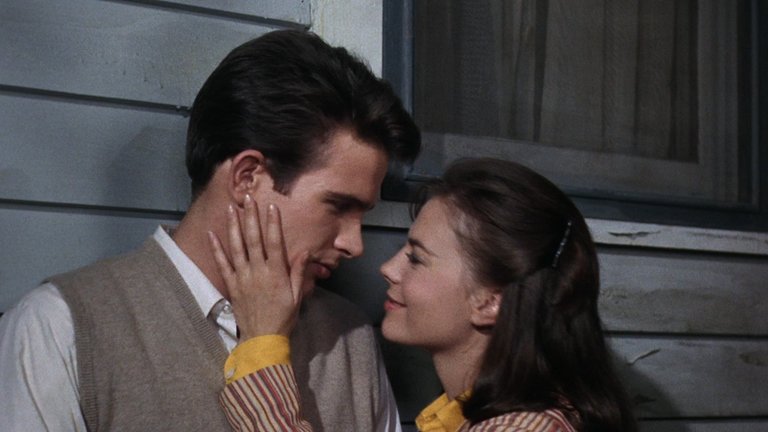Film Review: Splendor in the Grass (1961)

Elia Kazan, the grand Hollywood filmmaker of 20th Century, has undoubtedly earned his reputation for extracting the best possible performances from his cast. This ability is particularly apparent in his 1961 period drama, Splendor in the Grass, which single-handedly transformed the then-unknown Warren Beatty into a major Hollywood star and an enduring icon of 1960s cinema.
The screenplay for Splendor in the Grass was author by William Inge, a writer celebrated for his focus on Midwestern themes. Inge's script draws inspiration from his 1953 play, Glory in the Flower. The plot begins in 1928 Kansas, and introduces us to Wilma Dean “Deanie” Loomis, portrayed by Natalie Wood. Deanie is a high school student hopelessly enamoured with her classmate Bud Stamper, played by Beatty. Their relationship is the envy of their small town; however, it is fraught with challenges that threaten their happiness. Both characters experience not only romantic feelings but also intense sexual desire for one another. Yet, societal expectations weigh heavily on Deanie, who is admonished by her mother Frieda (played by Audrey Christie) to remain a “nice girl” and abstain from sexual relations until marriage. Conversely, Bud grapples with his own desires but faces pressure from his wealthy father, Ace Stamper (played by Pat Hingle), who insists that Bud should not marry Deanie—the daughter of a local butcher—at least not until he graduates from Yale University. This mounting sexual frustration ultimately takes a toll on both their relationship and Deanie’s mental health, almost leading towards tragedy.
Inge's own background as a closeted homosexual informs the narrative's exploration of suppressed sexual desires. The struggles faced by Deanie and Bud can be interpreted as partially autobiographical reflections of Inge’s own life experiences. This theme was notably bold for early 1960s Hollywood, which was still constrained by the prudishness of the Motion Picture Association of America (MPAA) Production Code. Inge compensates for this by injecting increased melodrama, which at times borders on campiness.
Despite being produced on the cusp of the Sexual Revolution, both Inge and Kazan convey a rather conservative message through their characters. Deanie’s portrayal as the quintessential “nice girl” finds its counterpart in Ginny, Bud’s flapper sister who embraces alcohol and sexual promiscuity of Jazz Age with abandon. Played energetically by Barbara Loden—who had a tumultuous romantic relationship with Kazan—Ginny appears somewhat shoehorned into the narrative as a means to connect the personal story with broader historical or political contexts. Her character arrives abruptly and departs just as quickly, with her fate resolved through mere dialogue rather than any substantial narrative development.
Ginny’s hedonistic lifestyle comes crashing down with the Wall Street Crash of 1929, which also devastates her father's fortunes. The subsequent Great Depression serves as a moral cleansing for both America and the protagonists. Despite their separation, Deanie and Bud find a measure of peace amid hardship. An ironic twist unfolds when Deanie’s mental breakdown precedes this economic catastrophe; her parents are forced to sell stocks to finance her treatment—stocks that soon become worthless. This ironic twist is never properly explored. Interestingly, Inge received an Oscar for Best Original Screenplay despite many critics considering the script one of the film's weaker aspects.
The film's music, composed by David Amram, is uninspiring and forgettable, but it is more than compensated for by Boris Kaufman's striking color cinematography, which makes Splendor in the Grass look modern. The film's locations in New York City and its surroundings adequately pass for Kansas.
What truly elevates Splendor in the Grass is its stellar acting ensemble. Warren Beatty delivers an impressive performance in his debut role, striving to meet Kazan's high standards of Method acting established by previous icons like Marlon Brando and James Dean. While some may view Beatty's efforts as overshadowed by these predecessors, he nonetheless demonstrates considerable talent that would soon catapult him to stardom.
For Natalie Wood, this film represents one of her most challenging yet rewarding roles. Despite reported tensions between her and Beatty during filming—ironic in light of their future off-screen romance—the chemistry between them is palpable. Wood's performance shines particularly during the infamous bathtub scene where she confronts her mother about her desires; here she showcases both vulnerability and sexuality. If there is any compelling reason to invest two hours in Splendor in the Grass, it is undoubtedly Natalie Wood’s captivating portrayal—a testament to her status as one of Hollywood’s most talented actresses.
he rest of the cast is solid, with Pat Hingle standing out as Bud's father, who uses his real-life injuries from a terrible accident before production to build his on-screen character.
While Splendor in the Grass is far from perfect, Kazan's good direction, high-quality melodrama, and superb acting make it a recommendable film as one of the more satisfying Hollywood productions of its time.
RATING: 7/10 (+++)
Blog in Croatian https://draxblog.com
Blog in English https://draxreview.wordpress.com/
InLeo blog https://inleo.io/@drax.leo
Hiveonboard: https://hiveonboard.com?ref=drax
Rising Star game: https://www.risingstargame.com?referrer=drax
1Inch: https://1inch.exchange/#/r/0x83823d8CCB74F828148258BB4457642124b1328e
BTC donations: 1EWxiMiP6iiG9rger3NuUSd6HByaxQWafG
ETH donations: 0xB305F144323b99e6f8b1d66f5D7DE78B498C32A7
BCH donations: qpvxw0jax79lhmvlgcldkzpqanf03r9cjv8y6gtmk9
Posted Using InLeo Alpha
One of my top ten movies for both actors. I was a teen when I first saw it. A powerful and impactful drama about love as a youngster and the different impact it has on each person.
Thanks for sharing.
!LADY
View or trade
LOHtokens.@justclickindiva, you successfully shared 0.0100 LOH with @drax and you earned 0.0100 LOH as tips. (1/20 calls)
Use !LADY command to share LOH! More details available in this post.